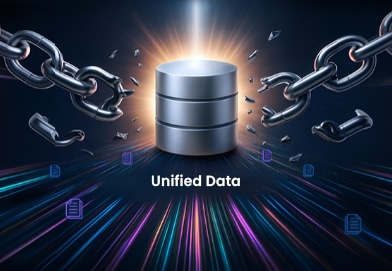I. Introduction

In the fast-paced world of big data, small and medium businesses (SMBs) in e-commerce face numerous challenges in staying competitive and maximizing their growth potential. One of the key factors that can make a significant difference for those businesses is data integration.
This blog will explore why data integration is critical for small and medium e-commerce businesses, how it can benefit them, and provide actionable insights on implementing effective enterprise data integration strategies.
II. Understanding Data Integration
A. Definition of Data Integration

Data integration combines data from diverse sources and systems into a unified and coherent view. It involves harmonizing data formats, resolving inconsistencies, and ensuring seamless data flow across an organization’s platforms, applications, and departments.
Data integration encompasses both unstructured and structured data. Structured data refers to organized and easily analyzable data that typically resides in a central hub called a data warehouse or a spreadsheet, which is usually represented in tables with predefined fields and relationships.
Unstructured data refers to information that does not follow a predefined format or structure. It includes textual data, social media posts, customer reviews, images, videos, and other content that may not fit into traditional database structures.
Data integration architecture involves handling structured and unstructured data, ensuring that relevant data from various sources is brought together, unified, and made accessible for analysis and decision-making.
B. Key Benefits of Data Integration

The benefits of data integration are manifold, presenting numerous advantages for businesses operating in various industries. By bringing together disparate data sets, organizations can:
Gain a Comprehensive View
One of the critical data integration benefits is that it enables businesses to create a holistic view of their operations, customers, and market trends. This comprehensive perspective helps make informed decisions and identify valuable insights from all the data.
Improve Decision Making
Integrated data provides accurate and up-to-date information, empowering businesses to make data-driven decisions. By analyzing trends, patterns, and customer behaviors, organizations can identify opportunities, optimize processes, and respond to market demands effectively.
Enhance Operational Efficiency and Facilitate Collaboration
Data integration streamlines business operations by eliminating manual data entry, reducing errors, and automating data synchronization. This efficiency boost saves time, improves productivity, and allows employees to focus on higher-value tasks.
Moreover, data integration enables different teams and departments to collaborate effectively. By breaking down data silos, organizations can foster better collaboration, enabling teams to collaborate more effectively and share valuable insights.
C. Key Challenges Faced by Small and Medium E-commerce Businesses

While data integration offers significant advantages, small and medium e-commerce businesses encounter specific challenges due to their limited resources and unique operational dynamics. Some common challenges are limited IT teams and data quality and consistency.
Limited It Infrastructure
SMBs often operate with limited IT resources and infrastructure, posing challenges in implementing robust data integration solutions. They need scalable and cost-effective integration options tailored to their requirements.
Data Quality and Consistency
E-commerce businesses rely on accurate and consistent data for inventory management, order fulfillment, and customer service. Data integration requires ensuring data quality, resolving discrepancies, and maintaining consistency across multiple systems.
System Compatibility
Small and medium e-commerce businesses may use off-the-shelf and custom-built systems. Integrating these systems can be challenging due to compatibility issues, different data formats, and APIs.
Security and Privacy Concerns
E-commerce businesses handle sensitive customer data, including personal information and payment details. Data security and privacy during integration are crucial to maintaining customer trust and complying with data protection regulations.
Resource Constraints
SMBs often face resource constraints, including budget limitations and limited technical expertise. Implementing data integration solutions that are affordable, user-friendly, and require minimal maintenance is essential for these businesses.
III. The Role of Data Integration in E-commerce

Data integration plays a crucial role in the success of e-commerce businesses, particularly small and medium enterprises. Let us explore how data integration benefits e-commerce businesses and optimizes their operations.
A. Centralizing Data from Multiple Sources
Inventory Management Systems
Data integration enables e-commerce businesses to centralize data from multiple sources, such as warehouses, suppliers, and online marketplaces. By integrating inventory systems, businesses can gain real-time visibility into stock levels, avoid stockouts, and ensure accurate product listings.
Customer Relationship Management (CRM) Platforms
Integrating the CRM system with e-commerce allows businesses to consolidate customer data, including purchase history, preferences, and demographics. This unified customer view helps personalize marketing campaigns, improve customer service, and drive loyal customer relationships.
Sales and order management systems
Integrating sales data and order management systems with e-commerce platforms streamlines order fulfillment. It automates the transfer of order details, tracking information, and inventory updates, reducing manual errors, improving order accuracy, and enhancing customer satisfaction.
B. Streamlining Operations
Eliminating Manual Data Entry and Errors
Data integrations eliminate the need for manual data entry, reducing human errors and saving time. Instead of duplicating efforts by manually entering data across multiple business systems, businesses can integrate these systems to ensure accurate and consistent data.
Automating Data Synchronization and Updates
By integrating systems, data synchronization and updates can be automated in real-time. For example, when an order is placed on an e-commerce platform, the integration ensures that inventory levels are automatically adjusted, payment information is synchronized, and the order status is updated throughout the systems, ensuring efficiency and accuracy.
C. Enhancing Data Accuracy and Consistency
Avoiding Discrepancies and Inconsistencies
Data integration eliminates data silos and ensures consistent information across different systems. This reduces the chances of discrepancies between inventory records, customer data, and sales figures. Accurate and consistent data enables better decision-making and improves overall business performance.
Ensuring Up-to-date and Reliable Information
Real-time data integration ensures data accessibility, allowing businesses to access the most up-to-date and reliable information. Whether it is inventory availability, customer data, or sales metrics, having accurate and timely information enables businesses to make informed decisions, respond quickly to market changes, and provide better customer service.
IV. Improved Decision Making and Business Insights

Data integration in e-commerce streamlines operations and empowers businesses to make informed decisions and gain valuable data insights. Let us explore how data integration improves decision-making and enables businesses to extract meaningful insights from their data.
A. Leveraging Integrated Data for Analytics and Business Intelligence
Integrated data enables e-commerce businesses to leverage analytics for better decision-making. By consolidating data from multiple sources, businesses can analyze key performance indicators (KPIs), perform customer segmentation, and conduct product analysis, empowering data-driven strategies.
B. Gaining a Holistic View of the Business
Data integration provides a unified view of e-commerce operations, customers, and performance. This comprehensive perspective helps businesses understand customer journeys, track sales funnel effectiveness, and make informed decisions based on accurate and consistent data across departments.
C. Identify Trends and Patterns
Integrated data facilitates the identification of market trends and patterns. By monitoring market trends and detecting seasonal patterns, businesses can adapt their strategies, optimize inventory management, and capitalize on demand fluctuations.
D. Making Data-Driven Decision Making
Integrated data empowers businesses to make data-driven decisions using quantitative data analysis, forecasting, and predictive analytics. This approach ensures decisions are rooted in empirical evidence, enabling businesses to optimize performance and drive sustainable growth.
V. Enhanced Customer Experience

A. Personalization and Targeted Marketing
Data integration empowers e-commerce businesses to deliver personalized experiences and targeted marketing campaigns. Businesses can segment customers based on demographics, purchase history, and preferences by leveraging integrated customer data. This enables personalized recommendations, tailored promotions, and improved customer engagement.
B. Efficient Order Management and Fulfillment
Data integration enables businesses to provide seamless omnichannel experiences. By integrating online and offline sales channels, businesses can offer consistent product information, pricing, and inventory availability across all touchpoints. This cohesive experience allows customers to switch channel effortlessly, fostering engagement and loyalty.
VI. Scalability and Growth Opportunities

A. Facilitating Expansion into New Marketplaces
Data integration is vital in facilitating the expansion of e-commerce businesses into new marketplaces. Integrating with different platforms and marketplaces allows businesses to seamlessly manage product listings, inventory, and orders across multiple channels. This scalability opens up new opportunities for reaching broader customer bases and driving business growth.
B. Integrating with Third-Party Applications and Services
Data integration enables e-commerce businesses to integrate with third-party applications and services. This integration allows businesses to leverage specialized tools for marketing, customer service, analytics, and more. By integrating these applications, businesses can enhance their operations, improve efficiency, and unlock new growth opportunities.
C. Enabling Process Automation and Efficiency
Data integration tools enable process automation and enhance operational efficiency. By automating data synchronization, order processing, inventory management, and other routine tasks, businesses can streamline their operations, reduce manual errors, and free up resources to focus on strategic initiatives. This increased efficiency improves productivity and lays the foundation for scalable growth.
VII. Overcoming Challenges in Data Integration
A. Integration Tools and Platforms for Small and Medium E-commerce Businesses
Small and medium e-commerce businesses face unique challenges regarding data integration. However, there are data integration tools and platforms specifically designed to cater to their needs. These solutions offer user-friendly interfaces, affordable pricing plans, and seamless integration with popular e-commerce platforms such as Shopify, WooCommerce, or Magneto.
For example, tools like Zapier or Skyvia provide pre-built connectors and easy-to-use workflows that enable businesses to integrate their systems without extensive technical expertise.
B. Considerations for Data Security and Privacy
Data security and privacy are crucial considerations when implementing data integration solutions. Small and medium e-commerce businesses must protect customer data, transaction details, and other sensitive information throughout the integration process. Implementing secure data transfer protocols such as HTTPS, employing encryption techniques, and adhering to industry standards and regulations (like GDPR or CCPA) are essential. Choosing integration tools and platforms that prioritize data security, offer robust authentication mechanisms, and provide data backup options can help mitigate risks.
C. Building a Data Integration Strategy
To overcome challenges in the data integration process, small and medium e-commerce businesses should take a systematic approach and build a comprehensive data integration strategy. This involves assessing integration requirements, evaluating suitable integration tools, planning integrating workflows, conducting thorough testing and validation, and implementing effective monitoring and maintenance practices.
Let us Help
Data Solutions can make all the difference in the functionality of how your data works for you. Think of this as a big circle – the more you understand your data, the better your data architecture is set up, and the more you can visualize your data and how it can work for you.
Talk to one of our data professionals today about making your data the best it can be!







